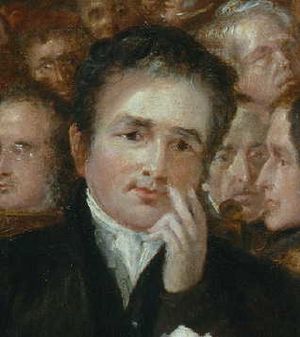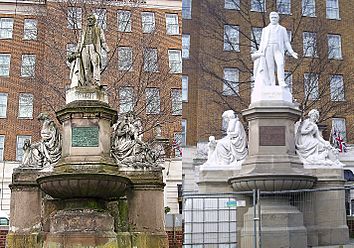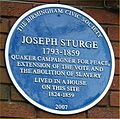Joseph Sturge facts for kids
Quick facts for kids
Joseph Sturge
|
|
|---|---|
 |
|
| Born | 2 August 1793 Elberton, Gloucestershire, England
|
| Died | 14 May 1859 (aged 65) Edgbaston, Birmingham, England
|
| Monuments | Joseph Sturge memorial |
| Education | Sidcot School |
| Known for | Founded the British and Foreign Anti-Slavery Society |
| Spouse(s) |
Eliza Cropper
(m. 1834)Hannah Dickinson
(m. 1846) |
| Children | 5, including Sophia Sturge |
| Relatives |
|
Joseph Sturge (born August 2, 1793 – died May 14, 1859) was an English Quaker, a person who worked to end slavery, and an activist. He started the British and Foreign Anti-Slavery Society, which is now called Anti-Slavery International. Throughout his life, he fought for important causes. He believed in peace, supported the rights of working people, and worked to free all enslaved people.
In the late 1830s, he wrote two books about a system called 'apprenticeship' in Jamaica. These books helped convince the British Parliament to free enslaved people sooner. In Jamaica, Joseph Sturge also helped start 'Free Villages' with the Baptists. These villages gave homes to newly freed slaves. One village was even named Sturge Town in his honor.
Contents
Joseph Sturge's Early Life
Joseph Sturge was born on August 2, 1793, in Elberton, Gloucestershire, England. He was the fourth of 12 children. His family belonged to the Religious Society of Friends, also known as Quakers. Quakers are a Christian group known for their peaceful beliefs and commitment to social justice.
Joseph went to school in Thornbury for a year. Then, he attended the Quaker Sidcot School for three years. After school, he worked on his father's farm. He believed in peace and refused to join the military in 1813.
Later, Joseph moved to Birmingham in 1822 and became a successful grain importer. He worked with his brother Charles and they invested in railways. Joseph later focused more on his social causes and public life. He became very involved in the movement to end slavery. In 1835, he was appointed an alderman, a type of local government official.
He became very interested in the island of Jamaica and the difficult lives of enslaved people there. He visited Jamaica several times. He saw firsthand the terrible conditions of slavery. He also saw how a system called 'apprenticeship' was used to control former slaves. He worked with African-Caribbean and English Baptists to fight for freedom.
In 1838, after full freedom was allowed, Sturge helped lay the foundation stone for the "Emancipation School Rooms" in Birmingham. In 1839, a marble monument was built in his honor in a Baptist church in Falmouth, Jamaica. It was dedicated to "the Emancipated Sons of Africa."
Fighting the Apprenticeship System
After Britain passed a law in 1833 to end slavery, some plantation owners in the West Indies tried to delay full freedom. They created a system called 'apprenticeship'. This meant that enslaved children under six were free, but older children and adults had to work for their former owners for up to 12 more years.
Joseph Sturge led a strong campaign against this unfair system. He was supported by other important figures like William Allen. In 1834, Sturge sailed to the West Indies to study the apprenticeship system himself. He traveled everywhere, talking to apprentices, plantation owners, and others.
When he returned to Britain, he published a book called Narrative of Events since the First of August 1834. He shared stories from people like "James Williams," an African-Caribbean witness, to show how cruel the system was. After another trip, he published The West Indies in 1837. Both books showed the harshness and unfairness of the apprenticeship system. They reported on the abuse of apprentices and how they were treated in prisons.
While in Jamaica, Sturge worked with Baptist churches to create Free Villages. These villages were meant to be homes for freed slaves, away from the control of plantation owners. He even bought two plantations on the island of Montserrat, Olveston and Elberton. He wanted to show that slavery was not needed for plantations to work.
Because of Sturge's determined efforts, the British government moved the date for full freedom forward to August 1, 1838. They ended the 12-year apprenticeship plan. For many people, August 1, 1838, became known as the true date slavery ended in the British Empire.
Working to End Slavery Worldwide

In 1839, Joseph Sturge and a small group of people founded the British and Foreign Anti-Slavery Society. Their goal was to end slavery all over the world. This organization still exists today as Anti-Slavery International.
The Society's first big event was the World's Anti-Slavery Convention. It was held in London in June 1840. People came from many places, including Europe, North America, South Africa, and the Caribbean. There were also women activists from the United States and many Nonconformists (Protestants who were not part of the Church of England).
In 1841, Sturge traveled to the United States with the poet John Greenleaf Whittier. They went to learn about slavery in America. When he returned, he published a book about his visit. During this trip, he also met William Jay, who was interested in promoting peace through international agreements.
The London Peace Congress of 1843
Joseph Sturge suggested holding a Peace Congress to the American Peace Society in 1841. He wanted to spread William Jay's ideas about peace. A first meeting was held in London in 1842. It was decided that the Peace Congress would happen right after the second Anti-Slavery Convention. Sturge ended up organizing both events.
The Peace Congress took place from June 22 to 24, 1843. It supported ideas for international organizations to help keep the peace between countries.
Politics and Social Reform
Joseph Sturge was also involved in politics and social reform movements in Britain. He joined the Anti-Corn Law League, which fought against taxes on imported grain. In 1842, he started a campaign for "complete suffrage," meaning everyone should have the right to vote. He hoped to unite different groups who wanted reform.
Sturge ran for Parliament three times between 1842 and 1847, but he was not elected. He ran in Nottingham and twice in Birmingham.
In Nottingham, he visited a Sunday School that taught not only religious lessons but also reading and writing. Sturge liked this idea and opened a similar school in Birmingham around 1845. He also helped start an Adult School movement and encouraged Quakers to open Sunday Schools.
Later Life and Legacy
Sturge became very interested in the cause of peace and solving conflicts peacefully. He helped start the Morning Star newspaper in 1855. This newspaper promoted the Peace Society and his other social ideas.
In 1854, Sturge and two other Quakers, Robert Charleton and Henry Pease, traveled to Saint Petersburg, Russia. They met with Tzar Nicholas I to try and prevent the start of the Crimean War. In 1856, Sturge and Thomas Harvey visited Finland to see the damage caused by British and French ships during the Crimean War.
Joseph Sturge married Eliza Cropper in 1834. After she passed away, he married Hannah Dickinson in 1846. They had five children, including Sophia Sturge (1849–1936), who also became a peace activist.
Death and Memorials
Joseph Sturge died suddenly at his home in Edgbaston, Birmingham, on May 14, 1859, from heart disease. He was buried in the graveyard at the Friends Meeting House in Birmingham. His family wanted a simple funeral, in line with their Quaker beliefs. However, many people attended, including the mayor, showing how much he was respected.
A memorial statue of Joseph Sturge was unveiled on June 4, 1862, at Five Ways in Birmingham. In 2007, the city held a ceremony to rededicate the statue. A blue plaque (a special marker) was also placed at the site of his former home in Edgbaston.
Images for kids



